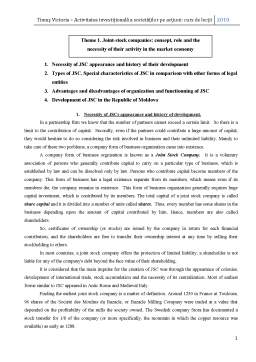Cuprins
- 1. Necessity of JSC appearance and history of their development
- 2. Types of JSC. Special characteristics of JSC in comparison with other forms of legal entities
- 3. Advantages and disadvantages of organization and functionning of JSC
- 4. Development of JSC in the Republic of Moldova
Extras din curs
1. Necessity of JSCs appearance and history of development.
In a partnership firm we know that the number of partners cannot exceed a certain limit. So there is a limit to the contribution of capital. Secondly, even if the partners could contribute a large amount of capital, they would hesitate to do so considering the risk involved in business and their unlimited liability. Mainly to take care of these two problems, a company form of business organisation came into existence.
A company form of business orgnisation is known as a Joint Stock Company. It is a voluntary association of persons who generally contribute capital to carry on a particular type of business, which is established by law and can be dissolved only by law. Persons who contribute capital become members of the company. This form of business has a legal existence separate from its members, which means even if its members die, the company remains in existence. This form of business organization generally requires huge capital investment, which is contributed by its members. The total capital of a joint stock company is called share capital and it is divided into a number of units called shares. Thus, every member has some shares in the business depending upon the amount of capital contributed by him. Hence, members are also called shareholders.
So, certificates of ownership (or stocks) are issued by the company in return for each financial contribution, and the shareholders are free to transfer their ownership interest at any time by selling their stockholding to others.
In most countries, a joint stock company offers the protection of limited liability; a shareholder is not liable for any of the company's debt beyond the face value of their shareholding.
It is considered that the main impulse for the creation of JSC was through the appearance of colonies, development of international trade, stock accumulation and the necessity of its centralization. Most of earliest forms similar to JSC appeared in Antic Rome and Medieval Italy.
Finding the earliest joint stock company is a matter of definition. Around 1250 in France at Toulouse, 96 shares of the Société des Moulins du Bazacle, or Bazacle Milling Company were traded at a value that depended on the profitability of the mills the society owned. The Swedish company Stora has documented a stock transfer for 1/8 of the company (or more specifically, the mountain in which the copper resource was available) as early as 1288.
The modern joint-stock corporation has many sources in medieval Europe. First among these was corporate law itself. Large amounts of wealth in Europe were actually controlled by corporate entities. Chief among these were church lands, the corporate entities being dioceses, religious orders and the Roman Church itself. These entities controlled a substantial fraction of the land in Western Europe. Furthermore cities (with varying degrees of political independence), merchant guilds, craft guilds, and many charitable entities (such as hospitals) were legal "corporations," i.e. artificial and perpetual legal persons under law. Some basic issues in corporate law (for example, when are officers individually liable for acts of the corporation, and when the corporation is liable for acts of its agents) had already been solved in canon law and urban law long before the joint-stock corporation.
Another source of the joint-stock corporation was the tradition of dividing ownership over tangible things into "shares." For example, it was common in Italian maritime states fund the construction and operation of ships by dividing them into a certain number of shares (24 and 64 were common divisions). Share owners were responsible for funding voyages (not including cargo, which was typically paid for by trading partnerships called commenda) as well as the initial construction capital, and divided up the profits (fees paid by the merchants less costs). This tradition faded away in Venice when that republic's government took over ship ownership, but thrived across the Italian penninsula in Genoa. Ship shares became embedded into maritime law all over Europe and even survived the British Empire (today in Canada when you register a boat the government still registers 64 shares in it for its owner). The only organization controlled by the shareholders, however, was the captain and crew of the ship.
The medieval organizations that most resembled later joint-stock corporations were the Genovese maone. These bore some strong resemblances to the publicani tax farming corporations of the Roman Republican era. In form and function maone also bore strong resemblances to some early joint-stock companies such as the Bank of Amsterdam, Bank of England, and the Dutch and English East India Companies.
The Italian cities often sold off their tax receivables to wealthy merchants at a discount as a way to borrow funds. The debts were divided into equal shares called loca or partes. Legally, these shares were personal property and could be freely traded.
Technically, no organization was created when the city sold its tax receivables to merchants. However, to effectively collect the taxes, the holders formed an organization called a maona or societas comperarum. This organization would then subcontract to tax farmers to collect the taxes. By the fourteenth century, Genovese maone also engaged in military conquest and colonization.
Preview document
Conținut arhivă zip
- Joint Stock Companies - Role, Concept, Necessity of the Activity.doc





















